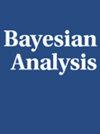基于层次广义变换模型的多响应类型联合贝叶斯分析
IF 4.9
2区 数学
Q1 MATHEMATICS, INTERDISCIPLINARY APPLICATIONS
引用次数: 10
摘要
考虑这样一种情况,分析员有一个对连续数据表现良好的贝叶斯统计模型。然而,假设观察到的数据集包含多种响应类型(例如,连续、计数、伯努利试验等),这些响应类型分布于多个分布类。我们将这些类型的数据称为“多响应类型”数据集。本文的目标是介绍一种合理的易于实现的通用方法,将用于连续响应的贝叶斯统计模型(称为首选模型)“转换”为用于多个响应类型数据集的贝叶斯模型。为此,我们考虑对多个响应类型数据进行转换,以便可以使用首选模型合理地对转换后的数据进行建模。我们策略的独特之处在于,我们将转换视为未知的,并使用贝叶斯方法对这种不确定性进行建模。我们对未知转换的贝叶斯方法的实现很简单,涉及两个步骤。第一步从潜在共轭多元(LCM)模型生成转换后的多个响应类型数据的后验复制。第二步涉及从优选模型隐含的后验分布生成值。我们通过贝叶斯加性回归树(BART)和时空混合效应(SME)模型的应用证明了我们模型的灵活性。我们对2019冠状病毒病(COVID-19)病例、道琼斯工业指数(DJI)调整后收盘价和谷歌趋势数据进行了全面的联合多响应型时空分析。©2022国际贝叶斯分析学会本文章由计算机程序翻译,如有差异,请以英文原文为准。
Joint Bayesian Analysis of Multiple Response-Types Using the Hierarchical Generalized Transformation Model
Consider the situation where an analyst has a Bayesian statistical model that performs well for continuous data. However, suppose the observed dataset consists of multiple response-types (e.g., continuous, count-valued, Bernoulli trials, etc.), which are distributed from more than one class of distributions. We refer to these types of data as “multiple response-type” datasets. The goal of this article is to introduce a reasonable easy-to-implement all-purpose method that “converts” a Bayesian statistical model for continuous responses (call this the preferred model) into a Bayesian model for multiple response-type datasets. To do this, we consider a transformation of the multiple response-type data, such that the transformed data can be reasonably modeled using the preferred model. What is unique with our strategy is that we treat the transformations as unknown and use a Bayesian approach to model this uncertainty. The implementation of our Bayesian approach to unknown transformations is straightforward, and involves two steps. The first step produces posterior replicates of the transformed multiple responsetype data from a latent conjugate multivariate (LCM) model. The second step involves generating values from the posterior distribution implied by the preferred model. We demonstrate the flexibility of our model through an application to Bayesian additive regression trees (BART) and a spatio-temporal mixed effects (SME) model.We provide a thorough joint multiple response-type spatio-temporal analysis of coronavirus disease 2019 (COVID-19) cases, the adjusted closing price of the Dow Jones Industrial (DJI), and Google Trends data. © 2022 International Society for Bayesian Analysis
求助全文
通过发布文献求助,成功后即可免费获取论文全文。
去求助
来源期刊

Bayesian Analysis
数学-数学跨学科应用
CiteScore
6.50
自引率
13.60%
发文量
59
审稿时长
>12 weeks
期刊介绍:
Bayesian Analysis is an electronic journal of the International Society for Bayesian Analysis. It seeks to publish a wide range of articles that demonstrate or discuss Bayesian methods in some theoretical or applied context. The journal welcomes submissions involving presentation of new computational and statistical methods; critical reviews and discussions of existing approaches; historical perspectives; description of important scientific or policy application areas; case studies; and methods for experimental design, data collection, data sharing, or data mining.
Evaluation of submissions is based on importance of content and effectiveness of communication. Discussion papers are typically chosen by the Editor in Chief, or suggested by an Editor, among the regular submissions. In addition, the Journal encourages individual authors to submit manuscripts for consideration as discussion papers.
 求助内容:
求助内容: 应助结果提醒方式:
应助结果提醒方式:


